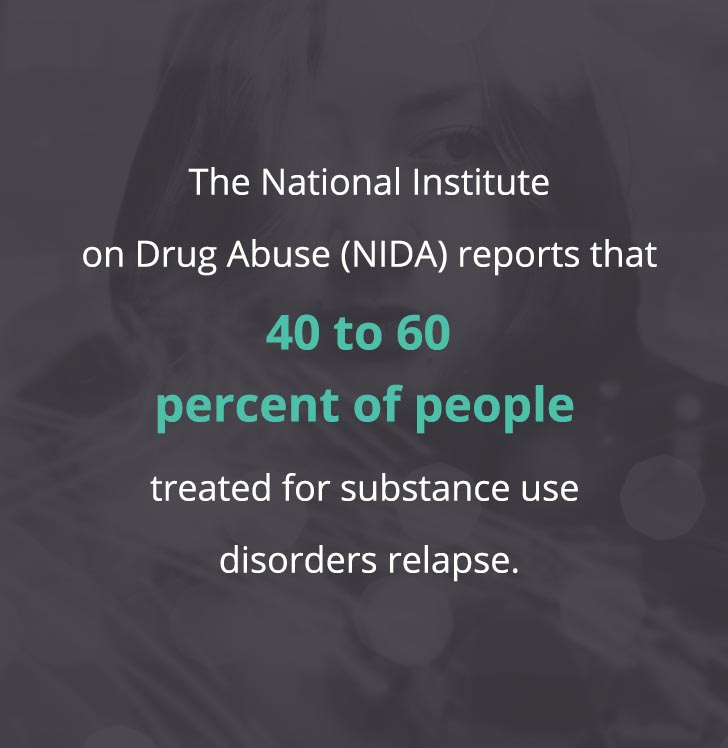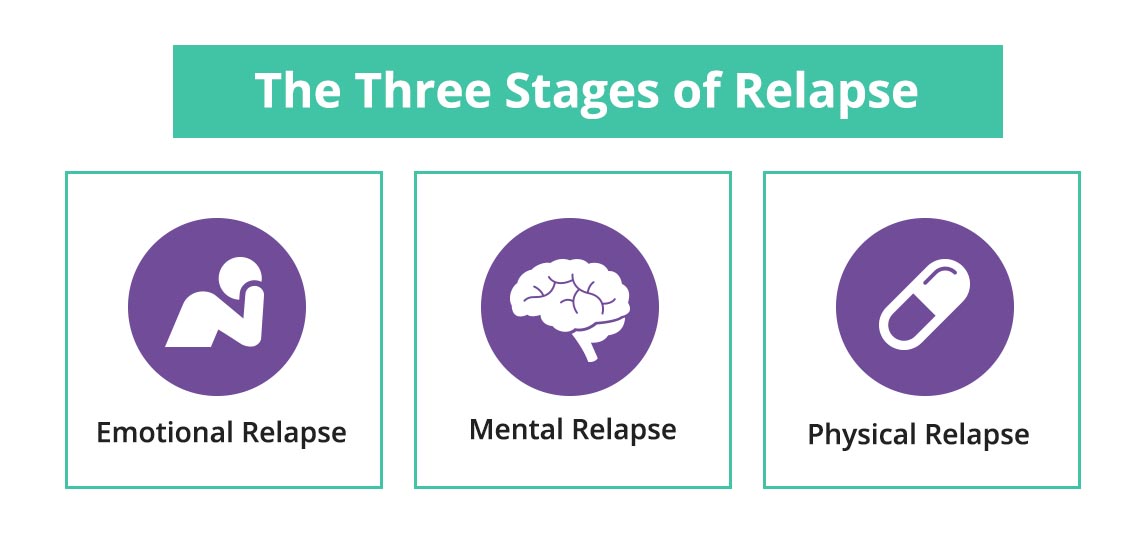
Triggers are social, environmental or emotional situations that remind people in recovery of their past drug or alcohol use. These cues bring about urges that may lead to a relapse. While triggers do not force a person to use drugs, they increase the likelihood of drug use. The National Institute on Drug Abuse (NIDA) reports that 40 to 60 percent of people treated for substance use disorders relapse.
Long-term drug use creates an association in the brain between daily routines and drug experiences. Individuals may suffer from uncontrollable drug or alcohol cravings when exposed to certain cues. The cravings act as a reflex to external or internal triggers, and this response can even affect individuals who have abstained from drugs or alcohol for a long time.
External Triggers
External triggers are people, places, activities and objects that elicit thoughts or cravings associated with substance use. Individuals in recovery can stay away from the dangers of external triggers by developing action plans to avoid triggers that remind them of past drug use. They should also be prepared to fight thoughts and cravings when they are in triggering situations.
A study by NIDA discovered that cocaine-related images subconsciously prompted the emotional centers of the brains of former users. These underlying stimuli and cues set off a rapid activation of the circuits associated with substance cravings.
The research maintained that subconscious cues are dangerous because they reinforce the patient’s desire to restart using drugs without them being aware of it. Researchers highlighted the importance of avoiding the people, places and things that remind patients of their former lifestyle.
People
People closest to the individual may set off cravings that eventually lead to a relapse. It is perilous for a person in recovery to be around substance-using friends and family. Even peers who abstain from illicit drugs can be dangerous. Offering alcohol to a former addict may trigger feelings that urge the individual to use drugs.
- Former drug dealers
- Friends
- Co-workers
- Employers
- Family members
- Spouses or partners
- Neighbors
Friends and family may not understand the consequences of negative behaviors toward people in recovery. These behaviors can make the individuals feel alienated and push them toward substance use.
Places
High-risk places remind former drug users of the times they engaged in substance use. Walking or driving through places where they used to drink or consume drugs can spark a memory connected to drug or alcohol use.
- Neighborhoods
- A friend’s home
- Bars and clubs
- Hotels
- Worksites
- Concerts
- A freeway exit
- Bathrooms
- Former drug-stash locations
- Schools
- Downtown
A person can find alternative routes to avoid high-risk places, such as places where they used to meet their dealers or bars where they used to binge drink.
Things
Objects in an individual’s everyday life may induce a craving. Cues such as spoons can trigger memories of drug use in former heroin users without them being aware.
- Paraphernalia
- Furniture
- Magazines
- Movies
- Television
- Cash
- Credit cards
- ATMs
- Empty pill bottles
A NIDA study maintains that exposure to drug-related objects may influence a former addict’s behavior. The brain registers these stimuli and processes them in the same areas involved in drug-seeking behavior.
Situations
People at risk of a relapse should avoid stressful situations that are likely to push them to use drugs and alcohol.
While holidays are a time of celebration for some, they may be a struggle for people in recovery. Holiday parties involving social drinking may be tricky. Family and friends often tempt those in recovery to consume alcohol because they are under the misconception that one deviation from the treatment plan will not be detrimental.
High-Risk Situations
| Events |
Behaviors Activities |
| Meeting new people |
Listening to a particular music genre |
| Recovery group meetings |
Going out to dance or eat |
| Parties |
Hanging out with friends or substance-using peers |
| Payday |
Driving |
| Calls from creditors |
After paying bills |
| Before, during and after work |
Before or during a date |
| Going out |
Alone in the house |
| Before, during and after sex |
After an argument |
| Anniversaries |
Talking on the phone |
| Holidays |
While eating lunch or dinner |
| Family gatherings |
|
Patients in rehab may consider skipping treatment sessions or support group meetings to spend time with their friends and family. A break in the routine may leave periods of isolation where patients may be inclined to use substances.
Internal Triggers
Internal triggers are more challenging to manage than external triggers. They involve feelings, thoughts or emotions formerly associated with substance abuse. When internal triggers arise, they can lead to questionable behaviors that deter recovery progress. Exposure to these cues may cause individuals to crave and use substances.
A study of rats by the University of Michigan found that the rats largely preferred rewards that triggered the brain’s amygdala, part of the limbic system that produces emotions. The researchers also discovered that the rats were inclined to work harder to obtain the reward that triggered the amygdala than the same reward that did not trigger any emotion in the brain.
Researchers deduced that the amygdala played an important role in producing focused and exclusive desire, similar to drug addiction. Internal triggers act in reverse, associating these signals to the substances that elicit them.
Emotions that can act as internal triggers may include:
- Fear
- Anxiety
- Guilt
- Irritation
- Overconfidence
- Anger
- Hate
- Jealousy
- Shame
- Depression
- Loneliness
- Feeling criticized, inadequate or overwhelmed
- Boredom
- Insecurity
- Nervousness
- Sadness
- Embarrassment
- Loneliness
- Pressure
- Tiredness
- Frustration
- Neglect
- Relaxation
- Celebratory feelings
- Excitement
- Happiness
- Passion
- Strength
- Confidence
- Exhaustion
- Feeling “normal”
- Sexual arousal
- How do I feel before using drugs or alcohol?
- How do I want to feel before using substances?
- In the last week, how did I feel when I used or wanted to use substances?
It’s important for people in recovery to be aware of the internal triggers they struggle with the most and have a plan in place to seek support when needed.
Stress Increases Vulnerability to Triggers and Relapse
A study from Marquette University pointed out that stress rendered people in recovery more vulnerable to other relapse triggers. Researchers followed the cocaine use patterns of stressed and unstressed rats and used a low dose of cocaine as a trigger. The stressed rats’ responses to the trigger mirrored those of people during relapse.
In rats and humans, the hormone corticosterone increases the level of dopamine, a brain chemical that plays a major role in reward-seeking behavior, in the brain in response to stress. Cocaine and several other illicit drugs also boost levels of dopamine. The Marquette researchers stated a stressed animal previously exposed to cocaine will crave the drug because the dopamine surge from cocaine trumps the release of stress-related dopamine.
After removing the corticosterone-producing glands from the rats, researchers observed a lack of relapse behavior after triggering them with low doses of cocaine. In contrast, when they increased the corticosterone levels, unstressed rats showed relapse behaviors when triggered.

The Stages of Relapse
Triggers for addictive behavior do not initiate immediate use.
When people in recovery succumb to triggers, their brains create reasons to use substances despite knowing that they must remain abstinent. This ongoing fight increases their vulnerability to cravings, which may result in a potential relapse.
Emotional Relapse
Former drug or alcohol users are in denial during emotional relapse, but they do not have thoughts of using. They are ashamed of the last time they relapsed and may have developed negative behaviors to cope with their thoughts. This state of mind is dangerous because it encourages bad health practices that can eventually lead to a full-blown relapse.
- Holding back emotions
- Isolation
- Avoiding
AA or
NA meetings
- Being reserved at meetings
- Focusing on other people’s problems
- Bad eating and sleeping habits
During therapy for people experiencing emotional relapse, patients are encouraged to identify their denial and focus on self-care.
Mental Relapse
Mental relapse, or relapse justification, is the continuous fight between wanting to use and knowing you should not use. Individuals often underestimate the dangers of situations and fall into the trap of single-time use. They give themselves permission to use substances in a controlled way, but the frequency of use generally increases until they fully relapse.
- Drug or alcohol cravings
- Thoughts about people, places and things associated with former use
- Glamorizing former use of substances
- Bargaining
- Lying
- Plotting to better control substance use
- Actively seeking relapse opportunities
- Planning a relapse
Education on coping skills can help people manage thoughts of using.
Physical Relapse
A physical relapse occurs when someone starts using again. It is the culmination of an emotional relapse and a mental relapse. Physical relapses are one of the most challenging stages of relapse to overcome. In many cases, users cave to drug use during a window of opportunity and falsely believe it will cause no harm.
Identifying Triggers
External triggers are easier to identify and manage than internal ones. Substance abuse treatment aims to help individuals recognize the early warning signs of relapse and develop healthy coping skills to thwart a potential relapse.
Managing External Triggers
Triggers that happen outside of the individual are not necessarily beyond control. There are multiple reminders of substance use in a former drug user’s life, including people, places and things. Asking the right questions and taking the correct steps can enable people in recovery to healthily transition to their normal life without risking a relapse.
Recovering individuals can carry out personal exercises where they make a list of the people, places and things that remind them of their substance-using life. Asking certain questions about external triggers can help prevent relapse.
Some of the questions can include:
- Do you think an upcoming event or situation will prompt substance cravings?
- Are you currently in a situation that triggers cravings? Can you leave?
- Are you stuck in a situation that forces you to think about substance use?
- Were you recently in a situation that sparked a thought about using substances?
- What drugs do you have around your house or in your car?
- What paraphernalia did you use with your drugs?
- What objects did you use when you took drugs and consumed alcohol?
- Do you have a non-using family member or friend who can purge your home from objects that remind you of your former life?
- How soon can you arrange for your family or friend to rid your home of drugs and related objects?
- With whom did you use substances?
- Who were your former suppliers?
- Do you have their phone number saved?
- What steps can you take to stop contact with your dealers and substance-using peers?
- Do you have family members or lovers who are substance users?
- How should you approach the situation if they are still using?
- What neighborhoods, streets, houses or other locations do you associate with drugs or alcohol use?
- Do you encounter these daily, while going to work, on a jog or on the way to treatment?
- Can you avoid high-risk areas?
- How do you plan to avoid these areas?
- What can you say to refuse drugs and leave the situation when someone pressures you?
Managing Internal Triggers
Individuals develop new thoughts, feelings and behaviors while using substances. These may include shutting family off, denying issues or justifying substance use. Healthier practices need to replace these negative internal processes in order to help people succeed in their path to a substance-free life.
Users in recovery can ask themselves some questions to help them understand their internal thoughts and feelings.
- How did I shut off my feelings?
- What are the benefits and risks of shutting off from friends and family?
- How can I change this?
- How did I change my thoughts to avoid reality?
- Did avoiding reality help?
- How can I change that behavior?
- Do I engage in specific behaviors to avoid difficult circumstances?
- What are the advantages and disadvantages of these behaviors?
- What types of behaviors would be healthier?
The earlier people in recovery can identify and successfully respond to triggers, the greater their chances of prolonged abstinence.
Medical Disclaimer: DrugRehab.com aims to improve the quality of life for people struggling with a substance use or mental health disorder with fact-based content about the nature of behavioral health conditions, treatment options and their related outcomes. We publish material that is researched, cited, edited and reviewed by licensed medical professionals. The information we provide is not intended to be a substitute for professional medical advice, diagnosis or treatment. It should not be used in place of the advice of your physician or other qualified healthcare provider.
Author
Author,
DrugRehab.com
Sonia Tagliareni is a writer and researcher for DrugRehab.com. She is passionate about helping people. She started her professional writing career in 2012 and has since written for the finance, engineering, lifestyle and entertainment industry. Sonia holds a bachelor’s degree from the Florida Institute of Technology.
View Sources
 Addiction
Addiction
 Treatment
Treatment
 Faith & Religion
Faith & Religion
 Active Recovery
Active Recovery
 Our Community
Our Community





